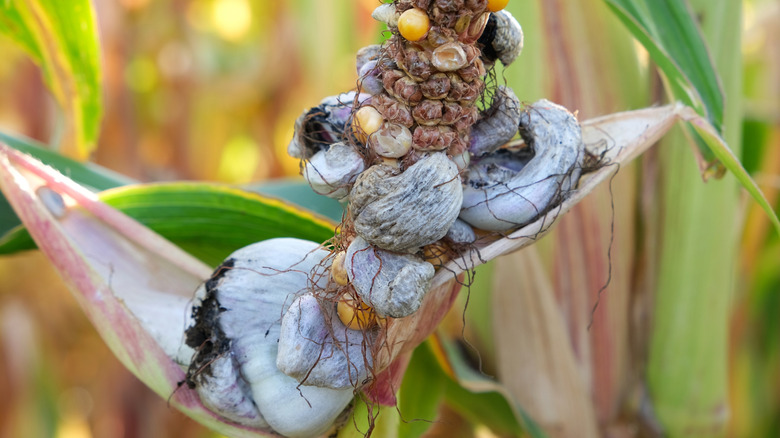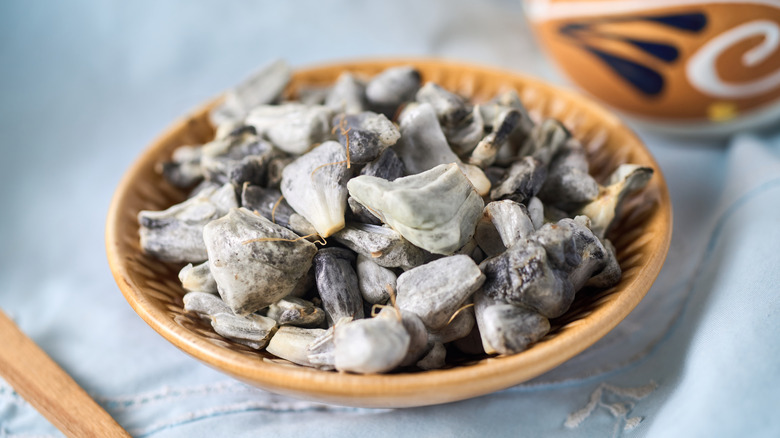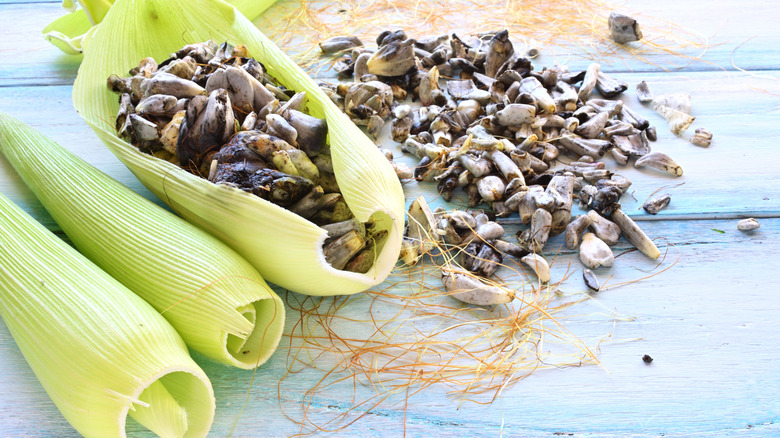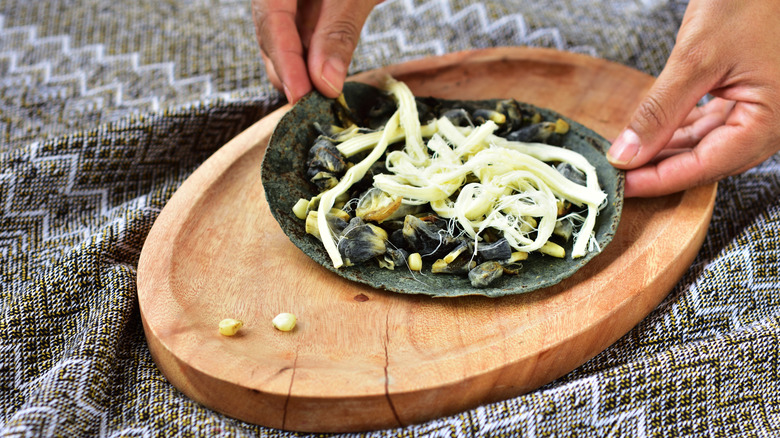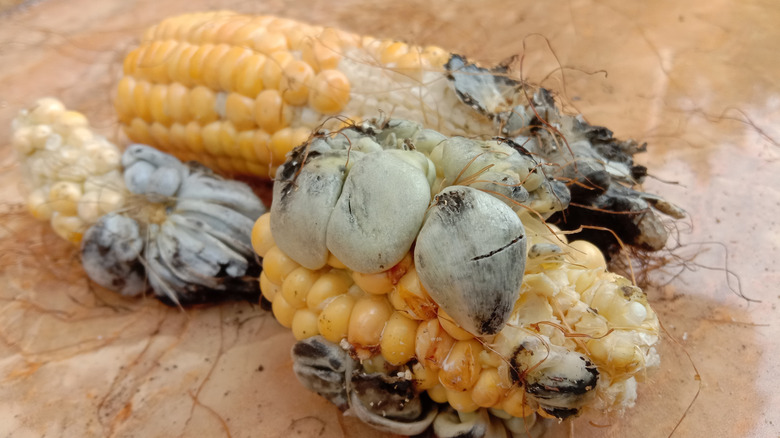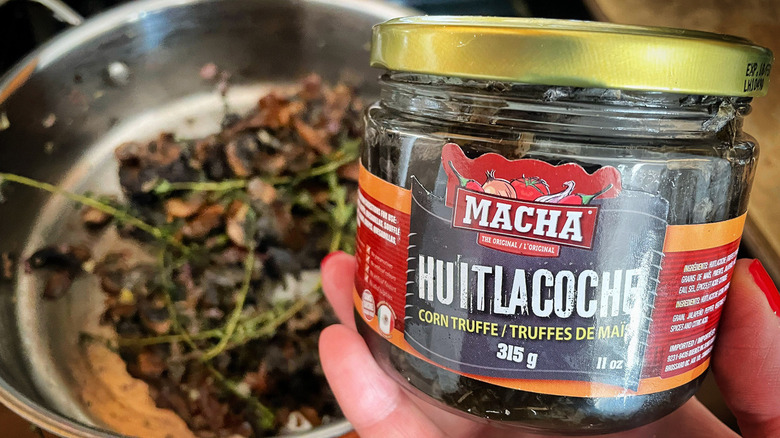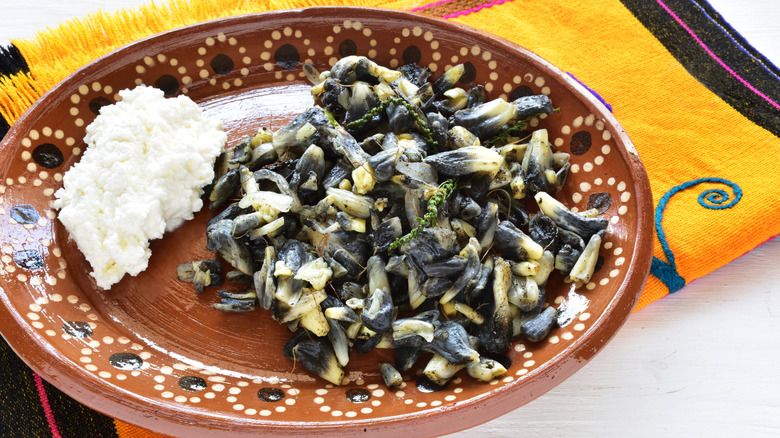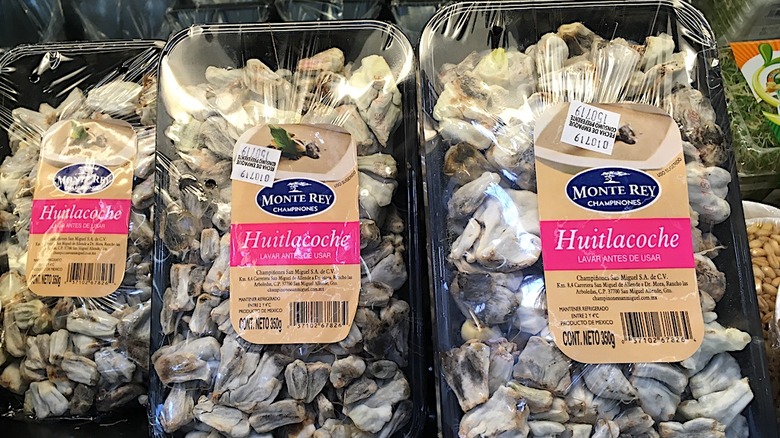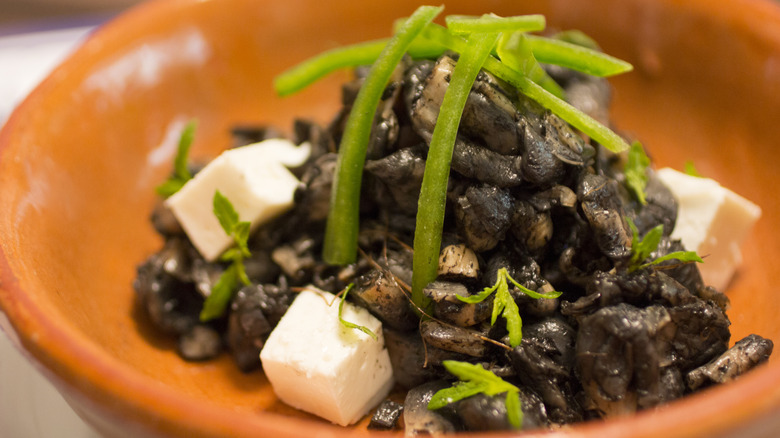What Exactly Is Huitlacoche And Is It Safe To Eat?
Don't let the appearance fool you. This fungus is one of Mexican cuisine's best-kept secrets, cherished for centuries and finally getting the global attention it deserves. Scientifically known as Ustilago maydis, it's a fungus that grows on corn, infecting the plant and transforming regular kernels into large, bulbous, gray-black structures. It's also known, less appetizingly, as corn smut.
Once infected, the corn develops tumor-like growths called galls. These can appear on nearly any part of the plant, including the ears, tassels, husks, and even the stalk. Early on, the galls are smooth and silvery-white, but as they mature, they become papery on the outside and filled with black, powdery spores on the inside. Essentially, regular sweet corn is overtaken by something that resembles an alien mushroom. And while that might sound like a crop disaster, and it's oftentimes treated as such, it is edible and it is actually a delicacy.
Yes, it's a fungus. But that's a good thing
Let's be clear, though, just because huitlacoche is a fungus doesn't mean it's something to fear. In fact, some of the most cherished foods in the world are technically fungi or shaped by them. Mushrooms, truffles (which have also seen a surge in popularity), blue cheese, miso, soy sauce, and even some new plant-based meats rely on natural fermentation or fungal activity to develop their distinctive flavors.
Huitlacoche, sometimes called a "corn mushroom," falls squarely into that category. It grows on ears of corn when the plant is exposed to moisture and warmth, and while it may be classified as a crop disease in some places, in Mexican culinary tradition, it's anything but unwanted. It's earthy, complex, and prized for its umami-rich profile.
So yes, it's a fungus. But so is the blue cheese in your wedge salad. If you're comfortable adding mushrooms to your pizza or shaving truffles over pasta, don't let huitlacoche's title hold you back, because it belongs in the same league.
Is it safe to eat?
In case it's not clear, yes, huitlacoche is safe to eat. Just because it's a fungus and technically a plant disease doesn't mean it's dangerous. In fact, it's been a part of traditional Mexican diets for centuries and is considered an indulgence in many regions.
Like mushrooms, huitlacoche is a culinary fungus, but not the kind you need to worry about in your fridge's mystery drawer when you forgot you had that bag of spring mix from three months ago. It's not toxic, moldy, or rotten, it's just different — and delicious.
When properly harvested and cooked, huitlacoche is safe to eat and full of nutrients. The only time you'd need to be cautious is if it's been improperly stored, like any perishable ingredient. If you're buying it fresh, treat it like mushrooms and keep it cool and use it quickly. So yes, it may look a little wild, but huitlacoche is just as safe (and tasty) as that portobello burger you had last week.
A pre-Hispanic ingredient with deep roots
Just like guacamole, which dates back centuries and was made with avocados called ahuacatl, huitlacoche has deep roots in Aztec tradition. Its name is rooted in Nahuatl, the ancient Indigenous language of the Aztecs, which is still spoken by more than a million people across Mexico today. While some farmers see huitlacoche as a crop failure, they saw it as a gift.
The earthy, nutrient-rich fungus had both ceremonial and medicinal uses. And while the rest of the world was trying to cure corn of this so-called "disease," Indigenous communities were cooking it, celebrating it, and passing it down through generations.
Huitlacoche remains a staple in parts of Central and Southern Mexico, especially during the rainy season (May through November), when it naturally thrives. Once a sacred ingredient in Aztec cuisine, it has since found a place on fine dining menus in the U.S. thanks in part to chefs like Josefina Howard, who helped introduce it to American diners through her restaurant Rosa Mexicano.
What does it taste like?
Huitlacoche is earthy, smoky, and packed with flavor, very different than the cob of corn it grows on. Most people compare it to mushrooms because of its rich umami taste, but beneath that rich, savory base lies a subtle sweetness and a hint of nuttiness that adds unexpected complexity to the flavor.
It's the kind of ingredient that makes chefs swoon and food lovers do a double-take. If you're into mushrooms, truffles, caramelized onions, or anything with big, bold depth, you'll probably fall for huitlacoche. Just don't go in expecting corn, because the fungus completely transforms the flavor — and in the best way possible.
Chef José Andrés describes it as "the most amazing, savory, smoky, incredibly textured fungus you can find." According to Andres, chef Claudio Foschi had this to say about huitlacoche: "You can say it's like a mushroom but it doesn't compare to anything else. That's why people call it a truffle, very earthy, very umami."
It's delicious and nutritious
If the earthy, smoky flavor doesn't win you over, the health benefits just might. Huitlacoche is one of those rare ingredients that checks all the boxes. It's delicious, versatile, and surprisingly nutritious. It's deeply satisfying on the palate, but behind the rich, savory flavor, it's packed with nutrients that are good for you.
It contains protein, fiber, healthy fats, vitamins, and minerals, and it's also rich in bioactive compounds that research has linked to antioxidant, antimicrobial, and anti-inflammatory properties. Some studies even suggest it may support brain health and heart function, thanks to its dopaminergic and antiplatelet activity.
Beyond the kitchen, huitlacoche has surprising industrial uses as well. Scientists have explored it as a natural way to remove heavy metals from water, and even as a tool in eco-friendly winemaking and sustainable manufacturing.
But don't let the science distract you too much because at the end of the day, huitlacoche is just tasty. The health perks are definitely a plus, though.
How it's used in dishes
There's no one way to eat huitlacoche, and that's part of the fun. This ingredient is wildly versatile, with a flavor that complements a wide range of savory dishes. From street food staples to chef-driven creations, there's no shortage of ways to put it to work in the kitchen.
You can sauté it, simmer it, or use it to stuff something, and it plays well with everything from cheese to chiles. Its meaty texture and umami-rich flavor also make it an excellent stand-in for meat in vegetarian dishes.
Chef José Andrés uses huitlacoche in everything from quesadillas and tacos to soups and empanadas. Forager chef Alan Bergo simmers it with onions and tomatoes, then folds it into a flour tortilla with Oaxaca cheese for a rich, savory quesadilla. And Rick Bayless swears by huitlacoche tacos, which are perfect whether you're working with fresh or frozen huitlacoche. You'll also find it folded into tamales, layered into empanadas, spooned into stews, or as toppings on breakfast chilaquiles.
Why it's still considered weird in the U.S.
Let's be real, "corn smut" doesn't sound very appetizing. While it's revered in Mexican cuisine and even served in Michelin-starred restaurants, American farmers usually treat it like a crop disease to be discarded. Which, to be fair, it is a natural fungal infection caused by Ustilago maydis that causes lumpy gray-black growths on corn. But that doesn't make it less delicious.
In some states like Iowa, huitlacoche is more likely to be tossed out than sautéed with garlic. Even when local farmers try to sell it, like the couple behind Eloteshop, who grow white corn near Des Moines, most passersby don't give it a second glance. Their biggest fans are Latin Americans and curious foodies who know what they're looking for.
In a country obsessed with flawless produce and marketable names, a lumpy gray fungus called smut doesn't exactly scream "next big thing." But if you can get past the name and the looks, huitlacoche just might be the best thing you've ever wrapped in a tortilla.
Where can you buy it?
Now that you're hopefully sold on huitlacoche, you're probably wondering where do you actually find it? In the U.S., it's still a bit of a rarity, but if you know where to look, you've got options.
Your best bet is starting at Mexican grocery stores or online retailers, where it's typically sold canned. Brands like La Costeña and San Marcos make it easy to keep a can or two in your pantry for whenever inspiration strikes. You can also buy it online at specialty food shops, such as Woodland Foods.
If you're lucky enough to live near a well-stocked farmers market or happen to catch one of the rare U.S. farms that grows it fresh, you might spot huitlacoche in its natural, mushroom-like form.
And of course, if you're more of a "let someone else cook it" kind of person, a growing number of Mexican and fusion restaurants are putting huitlacoche on the menu. In major cities like Los Angeles, New York, and Chicago, you'll find everything from huitlacoche tacos to tamales, quesadillas, and more.
Is it affordable or a splurge?
If you're looking to purchase some huitlacoche for your budget-friendly weeknight meal, you might need a backup plan. Prices can range from $15 to $20 per pound, which is significantly more than the average ear of corn or canned mushrooms.
The reason it costs so much more is that it is rare and difficult to grow. Fresh huitlacoche has a short harvesting window and requires just the right conditions. Farmers must monitor it closely to ensure the fungus develops properly, and harvesting it isn't as simple as yanking a cob off the stalk. It's delicate and labor-intensive.
In the U.S., it's even harder to get. Most American farmers have spent decades trying to avoid huitlacoche, not grow it, seeing it as a crop disease rather than a culinary gem. It's only in recent years that a handful of American farms have started growing it on purpose to meet demand from chefs and food lovers in the know.
So yes, huitlacoche is more expensive than your average produce aisle pick. But like truffles or saffron, part of what makes it special is its rarity.
How to store it
Whether you've found some fresh huitlacoche at a farmers market or picked up a jar from a Mexican grocery store, proper storage makes all the difference. If you're working with the fresh stuff, treat it like mushrooms and wrap it loosely before storing it in the fridge. However, keep in mind that just like mushrooms, it doesn't last very long, even in the fridge, so plan to use it within a few days. And like always, the fresher, the better.
On the other hand, canned, jarred, or frozen huitlacoche is much more forgiving. Once you open it, you can keep it in the fridge for a few weeks. Just be sure to transfer whatever you don't use into a sealed container and make sure it stays refrigerated. If you've got the frozen kind, keep it tightly sealed and use it within a few months for the best flavor and texture. The bottom line is that whether you're making tacos tomorrow or next Tuesday, huitlacoche has options, as long as you store it properly.
Why chefs are embracing it
From upscale dining in Mexico City to pop-ups in New York City, huitlacoche is having a moment. Chefs all over are using it to add deep, savory flavor to their dishes while celebrating its cultural roots and treating it not as an unwanted crop, but as the culinary treasure it has been for generations. Its profile makes it a perfect replacement for mushrooms or truffles, and it's tasty in everything from tacos to soups and pastas.
But don't expect to find it at Mexican restaurant chains or at Mexican restaurants that lean more into gimmicks than tradition. Huitlacoche isn't the kind of ingredient you'll see at spots that water down recipes or skip traditional techniques. For many Mexicans, featuring huitlacoche on the menu is a way to honor their ancestors and showcase Mexican ingredients with a rich history. At restaurants like Nicos in Mexico City or Rosa Mexicano in New York, it's been a staple for years. Now, more chefs across the U.S. are experimenting with it too, using it to bridge cultures and tell new stories.
